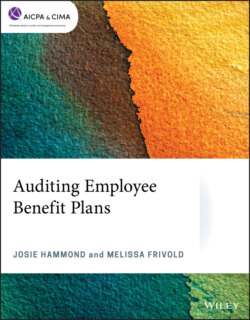Читать книгу Auditing Employee Benefit Plans - Josie Hammond - Страница 18
403(b) plans
Оглавление403(b) plans are employee savings plans similar to 401(k) plans. They are sponsored by churches, charitable organizations, and public schools. Employees are allowed to make voluntary pretax, voluntary after-tax or Roth contributions. Employers can make matching contributions or discretionary contributions. 403(b) plans have different eligibility standards and different allocation limit testing, and employee voluntary pretax and Roth contributions are not subject to the average deferral percentage test. Instead of an average deferral percentage test, employee pretax and Roth contributions are subject to universal availability.This means that nearly all employees must have the right to participate in the plan and they must be actively notified of that right. There are some exclusions from participation for students, persons hired to work fewer than 20 hours per week, and so on. There are no design-based exclusions for the employee contribution. There can be design-based exclusions for any employer contribution. Any employer contribution is subject to nondiscrimination testing, including the average contribution percentage test, just like employer contributions to a 401(k) plan.
Like qualified retirement plans, 403(b) plans are required to be documented in writing. The documentation, however, does not have to be a single document, but it must reflect all of the operating requirements of the plan. As a result of the changes in the plan’s operations created under the final IRS regulations effective in 2009, a 403(b) plan now functions a lot like a 401(k) plan, with a few notable differences. The main difference is in the discrimination testing, as described previously. Other key differences include
an additional catch-up contribution provision for long-service employees, separate from the age 50 catch provision provided for 401(k) and 403(b) plans;
the right to continue employer contributions to the plan for five years following severance of employment;
a limitation on allowable investments for most plans to insurance annuity contracts or shares in regulated investment companies;
the absence of a trust. 403(b) investments must be held by insurance companies or in a custodial account (which does not have the same protective features as a trust) and, as such, may be exempt from ERISA’s general requirement that plan assets be held in trust.
The 2009 Form 5500 was the first reporting period in which 403(b) plans needed to complete Schedule I or H and attach audited financial statements, if applicable. Many auditors found that plan sponsors did not have sufficient records to provide reasonable assurance that there were no material misstatements on beginning balances that may have affected the current year statement of changes. In such cases, the auditor was likely to be confronted with the need to modify his or her opinion for a scope limitation, a GAAP departure, or both. The Department of Labor issued Field Assistance Bulletin (FAB) No. 2009-2 and No. 2010-1, which permit certain 403(b) contracts to be excluded from Form 5500 reporting and outline other provisions with respect to what plans will require an audit, what steps should be taken to accumulate plan data, and so on. Where the plan administrator instructed the auditor to exclude certain plan assets from the scope of the audit, this could result in a scope limitation under generally accepted auditing standards (GAAS), as well as a departure from GAAP if the financials do not represent the entire plan entity. However, FAB No. 2009-2, as interpreted by FAB No. 2010-1, provides that a filing would not be subject to rejection by the DOL due to a modified opinion solely pertaining to the exclusion of the contracts meeting the definition in FAB No. 2009-2 from the financials or the scope of the audit. This exclusion and the associated modified opinion continues for the current Form 5500 filings for many 403(b) plans, as the records have not been located and the materiality of the excluded contracts cannot be determined. This is an area that will continue to develop as these plans go through successive annual audits. For further information regarding 403(b) plans, refer to the DOL’s website (https://www.dol.gov/agencies/ebsa/employers-and-advisers/plan-administration-and-compliance/retirement/reporting-and-coverage-for-403b-plans), as well as the AICPA Employee Benefit Plans Audit Quality Center website on 403(b) matters: www.aicpa.org/InterestAreas/EmployeeBenefitPlanAuditQuality/Resources/AccountingandAuditingResourceCenters/Pages/403(b)%20Plans.aspx.
